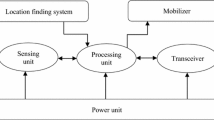Abstract
Wireless sensor networks (WSNs) comprise a large number of small sensor nodes scattered across limited geographical areas. The nodes in such networks carry sources of limited and mainly unchangeable energy. Therefore, it is necessary that these networks operate under energy efficient protocols and structures. Energy efficient clustering algorithms have been developed to reduce the networks energy consumption and extend its lifetime. This paper presents an innovative cluster-based communication protocol for WSNs. In order to reduce communication overhead, the authors propose an Energy Aware Clustering Hierarchy Protocol that creates a multi-level hierarchical structure to adequately route and collect data in WSN. The paper also propose an efficient clustering protocol which selects the best cluster head (CH) available and considers criteria such as residual energy, lower communication costs, cluster density, and minimum distance between cluster heads, cluster members and base station in order to contribute to an extension of network lifetime. Through extensive simulations, we show that our proposed protocol consumes the lowest amount of energy during the clustering process, selects the right number of CHs, and completes the clustering process quickly, when compared to state-of-the-art clustering mechanisms in WSN.












Similar content being viewed by others
References
Akyildiz, I. F., Su, W., Sankarasubramaniam, Y., & Cayirci, E. (2002). Wireless sensor networks: A survey. Journal of Computer Networks, 38(4), 393–422.
Awwad, S. A. B., Ng, C. K., Noordin, N. K., & Rasid, M. F. A. (2011). Cluster based routing protocol for mobile nodes in wireless sensor network. Wireless Personal Communications, 61(2), 251–281.
Sara, G. S., & Sridharan, D. (2014). Routing in mobile wireless sensor network: A survey. Telecommunication Systems, 57(1), 51–79.
Tsai, C. H., & Tseng, Y. C. (2012). A path-connected-cluster wireless sensor network and its formation, addressing, and routing protocols. IEEE Sensors Journal, 12(6), 2135–2144.
Wang, C., Shih, J., Pan, B., & Wu, T. (2014). A network lifetime enhancement method for sink relocation and its analysis in wireless sensor networks. IEEE Sensors Journal, 14(6), 1932–1943.
Manap, Z., Ali, B. M., Ng, C. K., Noordin, N. K., & Sali, A. (2013). A review on hierarchical routing protocols for wireless sensor networks. Wireless Personal Communications, 72(2), 1077–1104.
Lonare, S., & Wahane, G. (2013). A survey on energy efficient routing protocols in wireless sensor networks, computing, communications and networking technologies conference, pp. 1–5.
Jiang, C. J., Shi, W. R., Tang, X. L., Wang, P., & Xiang, M. (2012). Energy-balanced unequal clustering routing protocol for wireless sensor networks. Journal of Software, 23(5), 1222–1232.
Soro, S., & Heinzelman, S. (2009). Cluster head election techniques for coverage preservation in wireless sensor networks. Ad Hoc Networks, 7(5), 955–972.
Cook, B. S., Vyas, R., Kim, S., Thai, T., Le, T., Traille, A., et al. (2014). RFID-based sensors for zero-power autonomous wireless sensor networks. IEEE Sensors Journal, 14(8), 2419–2431.
Chen, Y. L., Wang, N. C., Shih, Y. N., & Lin, J. S. (2014). Improving low-energy adaptive clustering hierarchy architectures with sleep mode for wireless sensor networks. Wireless Personal Communications, 75(1), 349–368.
Boyinbode, O., Le, H., Mbogho, A., Takizawa, M., & Poliah, R. (2010). A survey on clustering algorithms for wireless sensor networks. In 13th International conference on network-based information systems, pp. 358–364.
Abbasi, A. A., & Younis, M. (2007). A survey on clustering algorithms for wireless sensor networks. Computer Communication, 30(14–15), 2826–2841.
Fuad, B., & Irfan, A. (2014). An efficient cluster-based communication protocol for wireless sensor networks. Telecommunication Systems, 55(3), 387–401.
Vhatkar, S., & Atique, M. (2014). Design issues and challenges in hierarchical routing protocols for wireless sensor networks. In International conference on computational science and computational intelligence, pp. 90–95.
Attea, B. A., & Khalil, E. A. (2012). A new evolutionary based routing protocol for clustered heterogeneous wireless sensor networks. Applied Soft Computing, 12(7), 1950–1957.
Heinzelman, W. B., Chandrakasan, A. P., & Balakrishnan, H. (2002). An application specific protocol architecture for wireless microsensor networks. IEEE Transactions on Wireless Communications, 1(4), 660–670.
Heinzelman, W. B., Chandrakasan, A., & Balakrishnan, H. (2000). Energy-efficient communication protocols for wireless microsensor networks. Hawaii international conference on system sciences, pp. 1–10.
Younis, O., & Fahmy, S. (2004). HEED: A hybrid, energy-efficient, distributed clustering approach for ad hoc sensor networks. IEEE Transactions on Mobile Computing, 3(4), 366–379.
Chamam, A., & Pierre, S. (2010). A distributed energy-efficient clustering protocol for wireless sensor networks. Computers and Electrical Engineering, 36(2), 303–312.
Pantazis, N. A., Nikolidakis, S. A., & Vergados, D. D. (2013). Energy-efficient routing protocols in wireless sensor networks: A survey. IEEE Communications Survey and Tutorials, 15(2), 551–591.
Kumar, D. (2014). Performance analysis of energy efficient clustering protocols for maximising lifetime of wireless sensor networks. Wireless Sensor Systems, IET, 4(1), 9–16.
Barati, H., Movaghar, A., Rahmani, A. M., & Sarmast, A. (2012). A distributed energy aware clustering approach for large scale wireless sensor networks. International Journal on Technical and Physical Problems of Engineering, 4(4), 125–132.
Zheng, J., & Jamalipour, A. (2009). Wireless sensor networks: A networking perspective. Hoboken: Wiley.
Kang, S. H., & Nguyen, T. (2012). Distance based thresholds for cluster head selection in wireless sensor networks. IEEE Communications Letters, 16(9), 1396–1399.
Chen, H., & Megerian, S. (2006). Cluster sizing and head selection for efficient data aggregation and routing in sensor networks. In IEEE wireless communications and networking conference, pp. 2318–2323.
Author information
Authors and Affiliations
Corresponding author
Rights and permissions
About this article
Cite this article
Barati, H., Movaghar, A. & Rahmani, A.M. EACHP: Energy Aware Clustering Hierarchy Protocol for Large Scale Wireless Sensor Networks. Wireless Pers Commun 85, 765–789 (2015). https://doi.org/10.1007/s11277-015-2807-2
Published:
Issue Date:
DOI: https://doi.org/10.1007/s11277-015-2807-2




